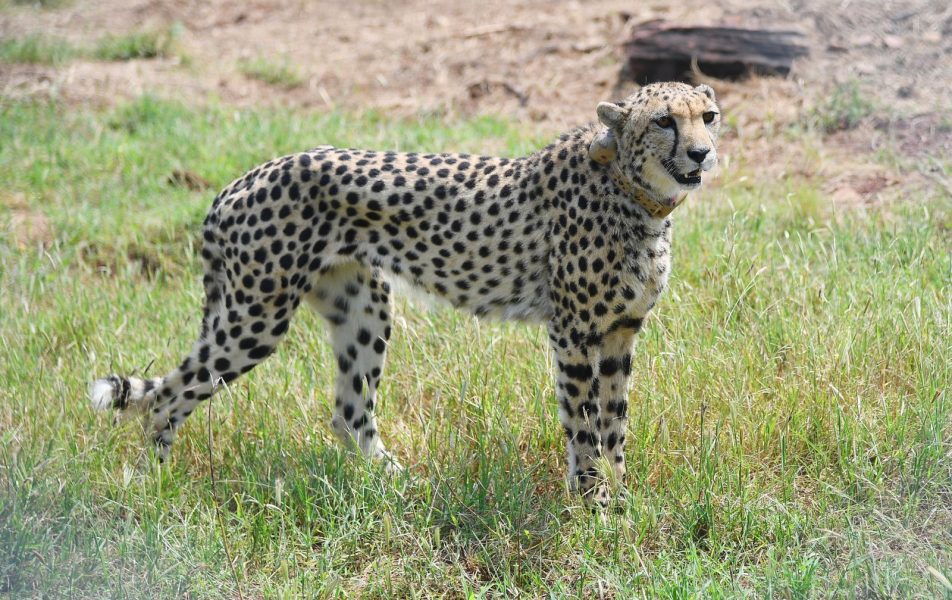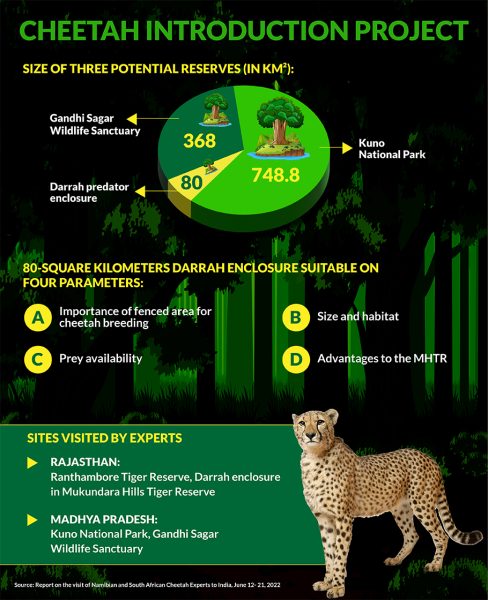
Cheetah relocation: Politics tilted choice in favour of MP’s Kuno

It was politics, not habitat, that allegedly decided the foster home of eight African cheetahs translocated in India’s wild recently. The Kuno National Park (KNP) in Madhya Pradesh was selected for the September 17 release of the felines brought from Namibia despite a team of foreign experts raising concerns about a few important parameters in the park, disclosed a highly placed source involved with the Cheetah Introduction Project.
After “surveying” three potential sites, the four-member team from Namibia and South Africa had certified Darrah predator-fenced enclosure within Mukundara Hills Tiger Reserve (MHTR) in Rajasthan as the “best suited” habitat for the cheetahs, the source pointed out.
Apart from the KINP and the MHTR, the visiting experts, accompanied by Indian officials, also surveyed Gandhi Sagar Wildlife Sanctuary in Madhya Pradesh for the cheetah release during their 10-day visit from June 12-21 this year.
Mukundara Hills Tiger Reserve: Experts’ unanimous choice
After visiting the sites, experts unanimously concluded that the predator-fenced enclosure at the MHTR could provide almost a “guaranteed success” in the breeding and growth of the cheetahs.
But, on August 24 — just 24 days before the cheetahs were finally introduced at the KNP — the National Tiger Conservation Authority (NTCA) informed the Rajasthan Chief Wildlife Warden that the “proposal for establishing cheetah population in the MHTR is not agreed”.
Many experts privy to the developments said politics was one of the major reasons that tilted the choice in favour of the KNP. “The Centre did not want this historic project to go to Congress-ruled Rajasthan,” said a top Wildlife Institute of India (WII) source.
Also read: Cheetahs are coming back to India the inside story of the homecoming
NTCA deputy inspector general Rajendra G Garawad, however, told the Rajasthan government that its proposal was turned down because “the management efforts are on to build up the tiger population at MHTR” and that “this site is also crucial as it provides corridor connectivity to the Ranthambore Tiger Reserve (RTR) for dispersal of tigers”.
Not many in Rajasthan though are convinced by the explanation as the experts had arrived at a conclusion after considering all aspects and visiting the RTR to see the tiger conservation success story.
“Experts had given their verdict, but politics ultimately prevailed over conservation parameters,” alleged Bharat Singh Kundanpur, the Congress MLA from Sangod constituency that covers the MHTR.
That the allegation is not entirely without basis is evident from the “observations and recommendations” of the visiting experts summarized in a nine-page report, a soft copy of which has been accessed by The Federal. The team found the 80-square kilometres Darrah enclosure suitable on four parameters: a) importance of fenced area for cheetah breeding, b) size and habitat, c) prey availability and d) advantages to the MHTR.

“All the experts were unanimous in their opinion that Darrah fenced predator enclosure within the MHTR is the best-suited site for establishing breeding, growing population of cheetah with an almost guaranteed success based on the experience with fenced reserves in their respective countries,” the report said. “This site supports a low density of competing predators and is most conducive for successful cheetah recruitment,” it added.
Ideal habitat and terrain
The experts further observed that “terrain within the enclosure is predominantly flat and vegetation is savannah scrubland/ open woodland with a small portion (1/3rd) of the area which is undulating forested habitat. The undulating forested habitat will provide well concealed den sites for lactating cheetah females. The habitat and terrain is ideal for releasing cheetahs and establishing a breeding population with two (02) breeding females and a coalition of males.”
On prey population, the report quoted the experts as saying: “The prey base for cheetahs is more diversified than Kuno and consists of good numbers of chinkara, nilgai, wild pig, black-naped hare and peafowl.”
Also read: Cheetahs: Their Mughal connection, and how they went extinct in India
Free-ranging tigers outside the enclosure within MHTR would not be a problem for cheetah introduction within the enclosure, the report said, quoting the experts. “The uniqueness of this combination of harbouring two charismatic large carnivores in one protected area has immense ecotourism potential as well as associated livelihood options and would greatly contribute to the economy of local communities in the region,” the report said.
Kuno National Park’s drawbacks
The team comprised director of the Cheetah Conservation Fund (CCF) of Namibia Dr Laurie Marker, and South African wildlife experts Dr Adrian Tordiffe, Simon Naylor and Vincent van der Merwe. They cited the presence of “competing carnivores” and the absence of “prey verities” as the main drawbacks of the KNP.
“….. all the experts expressed concern with the high leopard density of Kuno. There seems no immediate mitigation to this aspect in Kuno as removal of leopards would create vacant spaces that could be readily occupied by other leopards from the landscape — sometimes even resulting in the increase of leopard density due to removal of dominant territorial individuals,” the report said.
Speaking to The Federal over phone, Madhya Pradesh’s principal chief conservator of forest (PCCF), (wildlife) JS Chauhan said there were around six leopards in the KNP. “All except one young female were captured and relocated,” he said. “Isolating the young female from the cheetahs will not be a problem,” he said.
Following the recommendations of the experts, efforts are on to augment chital population through translocation from other sites in the state, he added. There are about 300 chital in the park, Chauhan disclosed.
Stating that all eight visitors are doing fine in their quarantine enclosure, he said they would be released in batches to larger enclosures any time after November 5. According to the schedule, cheetahs were to be shifted from the 50×30 meters quarantine enclosure for better acclimatization with their new environment on October 17.
Also read: Cheetahs to be back in India decades after extinction
The release was deferred because of the delay in getting requisite clearance from the veterinary department, the PCCF said. After a few months they will be finally released in the wild from the larger enclosure.
The jury is, however, still out on the success of the environment ministry’s Rs 90-crore African Cheetah introduction project conceived during the Congress-led UPA regime in 2009.
“The action plan appears to have substantially over-estimated cheetah carrying capacity at the first release site. We anticipate that neither Kuno National Park (which is only 748 sq km in area; unfenced; harbouring about 500 feral cattle; and surrounded by a forested landscape with 169 human settlements) nor the other landscapes considered are of the size and quality to permit self-sustaining and genetically viable cheetah populations,” wrote another group of environment scientists on October 19 in the environment journal, Nature, ecology and evolution. The concern was expressed by four Bengaluru-based biologists and their overseas colleagues.


